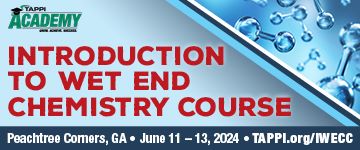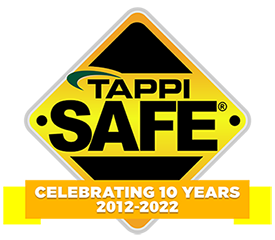 Search
Search
Use the search bar or filters below to find any TAPPI product or publication.
Filters
Content Type
Publications
Level of Knowledge
Committees
Collections
Journal articles

Magazine articles

Z-direction chemical analysis for new application methods, TAPPI Journal January 2023
ABSTRACT: In conventional wet-end chemical addition during paper production, chemical distribution through the z-direction of the sheet is usually not considered an important characteristic. With a nontraditional chemical dosing approach, such as foam-assisted additive addition, the chemistry can appear at different concentrations throughout the sheet, typically in a z-direction gradient. To fully understand the strength properties of the sheet, it is helpful to view or quantify the chemical distribution through the sheet in the z-direction. One qualitative method uses a dye technique along with confocal laser scanning microscopy to generate an image where the relative chemical concentration can be observed. A quantitative method involves compiling nitrogen analyses of layered subsections of the sheet into a composite graph of relative chemical concentration vs. the z-direction of the sheet. Chemical distribution analysis can be paired with traditional z-direction strength tests, such as Scott bond and z-direction tensile, to help one understand and improve the chemical addition process and its effects.
Journal articles

Magazine articles

The Mechanism of Bonding, TAPPI Journal September 2022
ABSTRACT: Three factors are involved in cellulose bonding--available area, contact, and hydrogen bonding.
Journal articles

Magazine articles

Ultrastructural Behavior of Cell Wall Polysaxxharides, TAPPI Journal April 2022
ABSTRACT: Considerable information on the ultrastructural organization of the plant cell wall and the supermolecular arragement of the cell wall components, in particular of cellulose, has been obtained with the electron microscope.
Journal articles

Magazine articles

Incorporation of post-consumer pizza boxes in the recovered fiber stream: Impacts of grease on finished product quality, TAPPI Journal March 2021
ABSTRACT: Grease and cheese contamination of used pizza boxes has led to misunderstanding and controversy about the recyclability of pizza boxes. Some collection facilities accept pizza boxes while others do not. The purpose of this study is to determine whether typical grease or cheese contamination levels associated with pizza boxes impact finished product quality. Grease (from vegetable oil) and cheese are essentially hydrophobic and in sufficiently high concentration could interfere with interfiber bonding, resulting in paper strength loss.Findings from this study will be used to determine the viability of recycling pizza boxes at current and future con-centrations in old corrugated containers (OCC) recovered fiber streams. These findings will also be used to inform the acceptability of pizza boxes in the recycle stream and educate consumers about acceptable levels of grease or cheese residue found on these recycled boxes.
Journal articles

Magazine articles

Dynamic out-of-plane compression of paperboard — Influence of impact velocity on the surface, TAPPI Journal February 2024
ABSTRACT: Processes that convert paperboard into finished products include, for example, printing, where the paperboard is subjected to rapid Z-directional (ZD) compression in the print nip. However, measuring and evaluating the relevant properties in the thickness direction of paperboard are not necessarily straightforward or easy. Measuring at relevant, millisecond deformation rates further complicates the problem. The aim of the present work is to elucidate some of the influences on the compressive stiffness. Both the initial material response and the overall compressibility of the paperboard is studied. In this project, the effect on the material response from the surface structure and the millisecond timescale recovery is explored.The method utilized is a machine called the Rapid ZD-tester. The device drops a probe in freefall on the substrate and records the probe position, thus acquiring the deformation of the substrate. The probe is also allowed to bounce several times on the surface for consecutive impacts before being lifted for the next drop. To investigate the time dependent stiffness behavior, the probe is dropped several times at the same XY position on the paperboard from different heights, thus achieving different impact velocities. The material response from drops and bounces combined allows study of the short-term recovery of the material. The material in the study is commercial paperboard. The paperboard samples are compared to material where the surface has been smoothed by grinding it. Our study shows that there is a non-permanent reduction in thickness and a stiffening per bounce of the probe, indicating a compaction that has not recovered in the millisecond timescale. Additionally, a higher impact velocity has an initial stiffening effect on the paperboard, and this is reduced by smoothing the surface.
Journal articles

Magazine articles

Recovery boiler back-end heat recovery, TAPPI Journal March 2023
ABSTRACT: Sustainability and efficient use of resources are becoming increasingly important aspects in the operation of all industries. Recently, some biomass-fired boilers have been equipped with increasingly complex condensing back-end heat recovery solutions, sometimes also using heat pumps to upgrade the low-grade heat. In kraft recovery boilers, however, scrubbers are still mainly for gas cleaning, with only simple heat recovery solutions. In this paper, we use process simulation software to study the potential to improve the power generation and energy efficiency by applying condensing back-end heat recovery on a recovery boiler. Different configurations are considered, including heat pumps. Potential streams to serve as heat sinks are considered and evaluated. Lowering the recovery boiler flue gas temperature to approximately 65°C significantly decreases the flue gas losses. The heat can be recovered as hot water, which is used to partially replace low-pressure (LP) steam, making more steam available for the condensing steam turbine portion for increased power generation. The results indicate that in a simple condensing plant, some 1%•4% additional electricity could be generated. In a Nordic mill that provides district heating, even more additional electricity generation, up to 6%, could be achieved. Provided the availability of sufficient low-temperature heat sinks to use the recovered heat, as well as sufficient condensing turbine swallowing capacity to utilize the LP steam, the use of scrubbing and possibly upgrading the heat using heat pumps appears potentially useful.
Journal articles

Magazine articles

Pigmented aqueous barrier coatings, TAPPI Journal November 2020
ABSTRACT: The desire for more sustainable packaging has led to the development of new packaging materials that are fiber based. Aqueous coatings are a pathway to improve the recyclability of these materials. Pigments used in these coatings can improve the performance of the coating and reduce cost while further improving the recyclability. Mineral pigments are also considered to be compost neutral. In this paper, we provide the reader a better fundamental understanding of the mechanisms by which pigments work in barrier coatings. A pigment’s mineralogy and physical characteristics are important to how it will perform, and there have been recent pigment developments that improve coating performance. This paper shows that some pigments are better than others in particular barrier applications. Also, pigmented base or pre-coats can be used to prepare the surface for more highly functional coatings that go on top, improving the barrier function of packaging material and reducing overall cost. Finally, the converting operation is of major importance in driving formulation choices for barrier applications.
Journal articles

Magazine articles

Editorial: Agility and adaptation in a dynamic business world, TAPPI Journal January 2021
ABSTRACT: As we move into 2020, it's interesting to look back at the research topics that were covered in TAPPI Journal (TJ) the previous year. Members of the TJ editorial board organized diverse special issues on lignin, coating ,forming, and diverse papermaking and biorefinery topics, which are discussed in the following sections.
Journal articles

Magazine articles

Real-time monitoring of bubble size distribution in a foam forming process, TAPPI JOURNAL August 2019
ABSTRACT: Foam forming is an intricate option to lessen fiber flocculation and to get better energy and water efficiency when making fiber-based products. Developed during the 1970s, this approach has recently received renewed attention, mainly because it also offers possibilities to widen the fiber-based product portfolios with novel and more valuable products. In addition to air content, bubble size is the most important property of foam. Foam quality control is essential for building real-world foam forming processes. In this work, we show how bubble size can be monitored with direct optical imaging in real time in real process conditions, and how such analysis helps adjust foam quality and discover process faults in foam forming.
Journal articles

Paper machine white water deaeration and two-stage flotation with channel flow, TAPPI JOURNAL July 2012
Paper machine white water deaeration and two-stage flotation with channel flow, TAPPI JOURNAL July 2012






